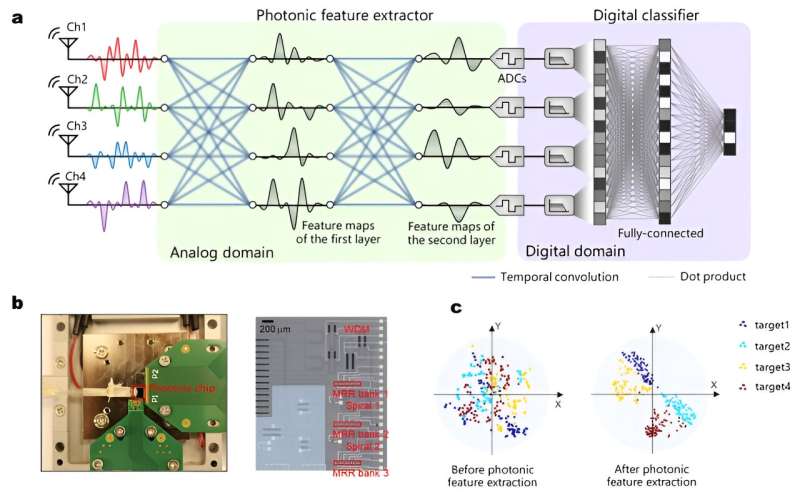This article has been reviewed according to Science X's editorial process and policies. Editors have highlighted the following attributes while ensuring the content's credibility:
fact-checked
peer-reviewed publication
trusted source
proofread
A photonic feature extractor for broadband radio-frequency signals

In intelligent sensing fields such as radar, machine vision and medical imaging, the critical information used for decision-making is often sparse. For example, a monosyllabic waveform requires thousands of sampling points, but contains only a few bits of information.
If key information can be extracted directly in the analog link of signal reception, the redundancy of data can be drastically reduced as well as the data rate. The challenge of digital processing can be significantly lessened.
Therefore, the so-called "analog feature extraction (AFE)" strategy has received extensive attention in the field of intelligent sensing. However, in the field of RF sensing, broadband signals of several GHz are usually required to discriminate target details. Under the bandwidth and reconfigurability bottlenecks of the existing RF circuits, the application of AFE strategy in the field of RF sensing faces challenges.
In a new paper published in Light: Science & Applications, a team of scientists led by Professor Weiwen Zou from State Key Laboratory of Advanced Optical Communication Systems and Networks, Intelligent Microwave Lightwave Integration Innovation Center (imLic), Department of Electronic Engineering, Shanghai Jiao Tong University, and co-workers have developed a photonic scheme to accomplish AFE of broadband RF signals.
In principle, photonics is considered a competitive candidate for RF signal processing due to its broadband capability and reconfigurability. If the physical structure of feature extraction in implemented in the photonic circuits, the input signals can be directly transformed into features without digital processing.
Based on this idea, they implemented a photonic chip that can output key features directly from the original RF signals received by the antenna. With these features, different targets are recognized with high accuracy. The reported scheme will provide a promising path for the efficient signal processing involved in autonomous driving, robotics, and smart factories.
The key part of their scheme is the photonic chip. "The feature extraction structure is essentially a convolutional neural network that outputs the spatiotemporal feature of the input signals. The photonic chip imitates the neural network to conduct feature extraction for the RF signals," the researchers say.
"Additionally, we designed an efficient training method especially for the photonic feature extraction system. It drastically decreases the cost of neural network training and makes the training possible.
"The experimental results indicate that the photonic feature extractor compresses the data rate four times while it maintains a good target recognition accuracy of 97.5%. We analyzed the results and found that the photonic spatiotemporal feature extractor achieves 7.7% better recognition accuracy than that without feature extraction.
"Compared with one-dimensional feature extraction, the spatiotemporal feature extraction performs 6% better. So, we testified to the effectiveness of the photonic feature extractor.
"We believe that our proposal will catalyze the development of naturally-efficient AFE strategies for broadband RF signal processing, and provide a promising path for the next-generation cognitive RF sensing systems."
More information: Shaofu Xu et al, Analog spatiotemporal feature extraction for cognitive radio-frequency sensing with integrated photonics, Light: Science & Applications (2024). DOI: 10.1038/s41377-024-01390-9



















